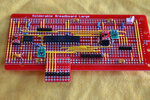The picture shows the vending machine control board I'm just finishing up. You may notice an abundance of 0.1" pitch KK type headers i have a couple tips to help get 0.1" pitch headers nicely installed.

The first tip is to use "lock" pcb footprints developed by Spark Fun. Alternate holes are positioned slightly above or below the baseline. This offset ensures the connector is perpendicular to the board. Details and links to the Spark Fun are at this link.
Jon's Imaginarium Lock Footprints
The second tip is to space header connectors on a grid according to the pitch of the headers, leaving an empty position between connectors. This leave room for the mating connectors. In the context of this discussion, it allows you to bridge all of the connectors with a female header strip, aligning the connectors. Add a couple of spring clamps and the connectors are held in position while you get them soldered in place.

The first tip is to use "lock" pcb footprints developed by Spark Fun. Alternate holes are positioned slightly above or below the baseline. This offset ensures the connector is perpendicular to the board. Details and links to the Spark Fun are at this link.
Jon's Imaginarium Lock Footprints
The second tip is to space header connectors on a grid according to the pitch of the headers, leaving an empty position between connectors. This leave room for the mating connectors. In the context of this discussion, it allows you to bridge all of the connectors with a female header strip, aligning the connectors. Add a couple of spring clamps and the connectors are held in position while you get them soldered in place.


